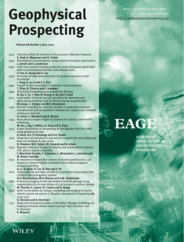
Full text loading...
 , Fabio Zyserman1
, Fabio Zyserman1 , Leonardo Monachesi2, Laurence Jouniaux3, Marina Rosas‐Carbajal4
, Leonardo Monachesi2, Laurence Jouniaux3, Marina Rosas‐Carbajal4
In glacial studies, properties such as glacier thickness and the basement permeability and porosity are key to understand the hydrological and mechanical behaviour of the system. The seismoelectric method could potentially be used to determine key properties of glacial environments. Here we analytically model the generation of seismic and seismoelectric signals by means of a shear horizontal seismic wave source on top of a glacier overlying a porous basement. Considering a one‐dimensional setting, we compute the seismic waves and the electrokinetically induced electric field. We then analyse the sensitivity of the seismic and electromagnetic data to relevant model parameters, namely depth of the glacier bottom, porosity, permeability, shear modulus and saturating water salinity of the glacier basement. Moreover, we study the possibility of inferring these key parameters from a set of very low noise synthetic data, adopting a Bayesian framework to pay particular attention to the uncertainty of the model parameters mentioned above. We tackle the resolution of the probabilistic inverse problem with two strategies: (1) we compute the marginal posterior distributions of each model parameter solving multidimensional integrals numerically and (2) we use a Markov chain Monte Carlo algorithm to retrieve a collection of model parameters that follows the posterior probability density function of the model parameters, given the synthetic data set. Both methodologies are able to obtain the marginal distributions of the parameters and estimate their mean and standard deviation. The Markov chain Monte Carlo algorithm performs better in terms of numerical stability and number of iterations needed to characterize the distributions. The inversion of seismic data alone is not able to constrain the values of porosity and permeability further than the prior distribution. In turn, the inversion of the electric data alone, and the joint inversion of seismic and electric data are useful to constrain these parameters as well as other glacial system properties. Furthermore, the joint inversion reduces the uncertainty of the model parameters estimates and provides more accurate results.

Article metrics loading...

Full text loading...
References


Data & Media loading...

